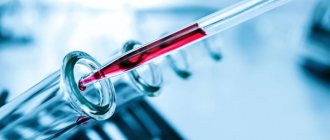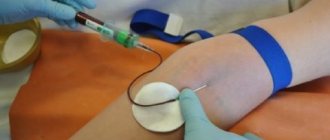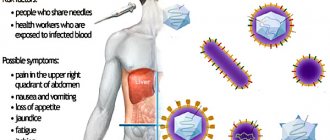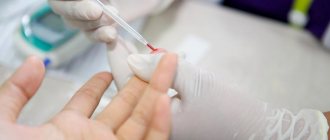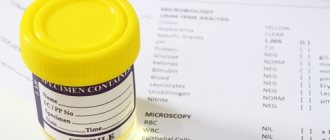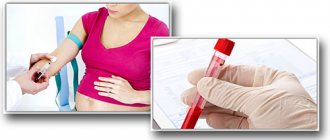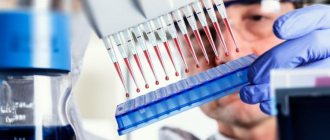EDS (blood test) - what is it? How is it carried out? Why is it needed? To fully understand these issues, it is necessary to refer to some medical information and data provided by a variety of diagnostic laboratories. In fact, understanding what we are talking about is not as difficult as it seems. Almost every citizen of a particular country sooner or later encounters EDS diagnostics. What is she like?
What is the non-treponemal method?
As you know, syphilis is caused by Treponema pallidum, which is a spirochete (spiral-shaped bacteria). After its introduction, the body begins to produce antibodies (IgG and IgM immunoglobulins) to lipoproteins and phospholipids, which are released as a result of cell damage by the spirochete, and to the membrane lipids of the pathogen itself. Antibodies to lipids appear in the blood about a month after infection. Using this test for primary syphilis, they are detected in the blood in 90% of cases 6 weeks after infection. With secondary syphilis, a positive result is recorded in almost 100% of cases.
The causative agent of syphilis is the spiral-shaped bacterium Treponema pallidum.
Decoding
Deciphering a blood test for EDS consists of determining the fact of the disease and its degree. Each specific analysis must be interpreted by a doctor. Based on the results of the analysis, a conclusion is drawn - positive (about the presence of the disease) or negative (about the absence of the disease).
The number of pluses indicates the degree of likelihood of the disease. One plus is considered a dubious result, two signs indicate a weak reaction. Three and four signs indicate the presence of a disease. However, if three pluses are determined, an additional analysis with treponemal diagnosis is carried out.
After the study, not only the presence or absence of a reaction is indicated, but titers are also written, which show how much antibodies are in the blood. So, if a sick patient is being diagnosed, then the shooting ranges allow one to judge the dynamics of treatment. The positive effect is characterized by a 4-fold decrease in titers. The absence of immunoglobulins in the blood indicates the absence of the disease.
A situation may arise when the reaction to EDS is negative, but titers and IgG are indicated in the analysis. This situation can be interpreted as “secondary” syphilis. In this case, there are antibodies in the blood, but they can remain in it for a long time after recovery.
Decoding the results
Disadvantages of the method
The main disadvantage of EDS is its low specificity and the possibility of false-positive results. The fact is that antilipid antibodies can be produced not only during syphilis, but also for other reasons. Among them:
- chronic and acute diseases: tuberculosis, hepatitis, systemic lupus erythematosus, tumors, inflammatory heart diseases, blood diseases, diabetes mellitus, scleroderma, dermatoses and others;
- physiological conditions: menstruation, pregnancy;
- anesthesia, taking certain medications;
- drug addiction, alcoholism;
- consuming fatty foods and alcohol the day before donating blood.
Another disadvantage is the false negative results that can occur early in the disease. That is, the patient is infected, but the analysis showed a negative reaction.
In addition, such testing is useless at the late stage of syphilis due to lack of sensitivity.
What is a blood test for EDS?
EDS is an express method for diagnosing syphilis. Also called RW, which is short for “Wassermann reaction”. The analysis is named after the scientist who first proposed this type of research. EDS blood test has long been known as an inexpensive, quick way to diagnose syphilis. This study is included in the list of necessary medical examinations. Its simplicity and information content makes it possible to identify a dangerous disease in the initial stages. If the disease is not detected in time and not treated, it progresses, affecting organs, developing into a chronic form. With early diagnosis, the disease can be successfully treated.
EMF or RV analysis
How is the analysis carried out?
Venous blood is usually used for research. It is taken in the morning on an empty stomach, that is, the last meal should occur no later than 8 hours before the procedure. It is not recommended to drink alcohol or eat fatty foods the day before.
Venous blood is taken to test for syphilis.
Two to three drops of the patient's blood serum are mixed with the cardiolipin antigen in a well of a glass plate and the reaction is observed, which lasts for 30 minutes. The conclusion is made based on the amount of sediment and the size of the flakes formed. The intensity of the reaction is assessed on a scale from one to four (+, ++, +++, ++++).
If the reaction is positive, confirmation of the result using treponemal tests is required.
Positive result
For example, a positive EDS blood test result. It occurs when a person’s blood, after mixing it with a special solution, produces antibodies to syphilis.
Accordingly, it can be judged that the patient’s body has encountered a disease. It makes no sense to talk about the norm for this analysis. After all, it shows whether there is syphilis or not.
Typically, laboratories simply provide the public with a printout that tells them whether antibodies to the disease have been found or not. But sometimes clinics offer an extended display of the result.
Analysis transcript
The EMF result can be either negative or positive. The more advantages, the more serious the defeat:
- + and ++ – weakly positive reaction (with one plus, the result is considered doubtful);
- +++ – positive;
- ++++ – strongly positive.
As a result of the study, antibody titers are indicated. If the analysis is carried out to monitor treatment, then the titers determine whether recovery has occurred. As a rule, after treatment the patient is monitored for a year. During this time, it is tested several times. The effectiveness of treatment is indicated if titers have decreased fourfold or more over the course of a year. If there are no IgM immunoglobulins in the blood, then there is no resumption of infection. IgG immunoglobulins may be present in the blood for a long time after treatment, sometimes even throughout life.
The test result may be negative or positive
What to do if you test positive for syphilis
Firstly, you need not to panic and consult a doctor for additional advice. Perhaps the study standards were violated or other factors influenced the result. It is recommended to donate blood again.
- when planning and managing pregnancy, to identify the disease during medical examination,
- future donors,
- workers who require a medical certificate.
It is recommended that people at risk undergo the study, for example: children of infected parents, people in contact with patients who have had unprotected sexual intercourse.
There is also a household way of spreading infection. Therefore, if you want to know whether everything is normal with your health, undergo tests in a timely manner and follow preventive measures.
When do cardiolipin antibodies appear in the blood?
Antibodies to cardiolipin, the presence of which allows the EDS method to diagnose, appear already at the stage of early infection, or during the period of primary syphilis. This time approximately corresponds to 7 or 10 days after the onset of primary affect or chancre. All non-treponemal methods, including the Wasserman reaction, are unable to distinguish between individual types of antibodies and give only the overall reaction of the immune response, and this is their imperfection. It is known that class M immunoglobulins appear first, which classically indicate a rapid response of the defense system to the introduction of a pathogen, and then, after a few weeks, class G immunoglobulins are produced, which in the case of syphilis remain in the patient’s blood for life.
The advantage of EDS is that this diagnostic method is highly sensitive for fresh forms of the disease: primary and secondary syphilis. But even among non-treponemal research methods, there are more sensitive and modern methods than the Wasserman reaction. This is the same reagin test or, for example, the precipitation reaction.
Of all the groups of non-treponemal tests, it is the Wasserman reaction that has the largest number of false positive results, since it is quite old. In other words, antibodies are detected, but the person does not have syphilis. In this case, additional methods for diagnosing syphilis are carried out on such a patient, and for the time being his planned hospitalization or issuance of a health certificate is suspended. To confirm or refute the diagnosis using specific treponemal tests, the patient needs additional examination at a dermatovenereal dispensary.
True, the cardiolipin test has one “pleasant” feature. Antibodies against this antigen disappear from the blood serum over time, appearing in the acute phase of the disease, and most often as a result of successful treatment. Therefore, by performing this test repeatedly, one can judge the effectiveness of treatment measures. But a serious treponemal confirmatory test, such as the passive hemagglutination reaction RPHA, does not show such a change, since in this case the antibodies are determined to other syphilitic specific antigens.
Laboratory detection of the causative agent of syphilis
Treponema pallidum (the causative agent of syphilis) belongs to gram-negative bacteria of the spirochete species. In 95% of cases, infection occurs through unprotected intimacy. Contagiousness (infectiousness) is manifested by the concentration of bacteria in the secretory fluids of an infected person (sperm, vaginal secretions) and microscopic damage to the mucous membranes of the partner.
The bacterium enters the intercellular junctions of the endothelium, cells and tissues, and multiplies in the lymph nodes. The high virulence of treponema pallidum ensures the rapid spread of infection throughout the body through the blood and lymph flow.
Treponema pallidum is not detected under a light microscope and does not grow on nutrient media, which excludes conventional microscopic analysis and bacteriological culture (bacteriological culture) from laboratory practice. The bacterium can only be detected in blood serum through serological tests.
RPR in the list of diagnostic methods for determining Treponema pallidum
Serological blood testing is based on the body’s immune reactions: the interaction of antigens (bacteria or viruses) that have entered the blood and Ig immunoglobulins - specific blood plasma proteins responsible for the differentiation and destruction of antigens.
Reference! Antibodies to foreign pathogens are called immunoglobulins, and serological reactions are called antigen-antibody reactions.
Treponemal and non-treponemal tests are used to diagnose syphilis. Treponemal testing is a complex and expensive method using actual Treponema pallidum antigens. They are necessary to confirm the diagnosis in case of false positive results.
The list includes reactions:
- immunofluorescence (RIF);
- immobilization of Treponema pallidum (RIBT);
- passive hemagglutination (RPHA).
Enzyme-linked immunosorbent assay (ELISA) and immunochemiluminescence (ICL) are similar. In non-treponemal tests, cheap nonspecific antigens are used for the antigen-antibody reaction and immunoglobulins are not separated by titers, but their total amount is determined. Non-treponemal studies include RPR, which is used to quickly diagnose syphilis.
Indications and rules for blood sampling
Blood for this study is taken from a peripheral vein, and no restrictions or special measures need to be taken before donation. Only people who smoke need to make an effort and not smoke for at least half an hour before taking the test.
This test is used as a screening test for the initial diagnosis of syphilitic infection, or to assess the effectiveness of treatment. Decreed groups of the population are subject to screening research. These include:
- donors, including organs before their removal (for example, kidneys, red bone marrow or parts of the liver from relatives);
- pregnant women;
- working in the food industry or selling food products;
- employees of children's educational and medical institutions;
- all patients admitted for planned treatment to medical institutions.
Also, rapid diagnosis of syphilis is first carried out when there is a primary suspicion of this infection. Most often, this is an unfavorable sexual history, various complaints associated with enlarged inguinal lymph nodes, the appearance of various ulcers on the genitals, the presence of other sexually transmitted diseases, and also if it turns out that the sexual partner has syphilis. Indications also include blood tests of a newborn child if the mother was previously diagnosed with syphilis.
Class affiliation of cells lgM or lgG
The class affiliation of the lgM or lgG cells is indicated: when treponema enters the body, the immune system begins to react violently to the penetration of foreign cells. First, antibodies such as lgM are formed. They can be detected within a week after a person becomes infected. IgG appears in the body after about a month and can remain in it for a long period, even if the disease has been successfully treated. The presence of this class may indicate that the body has developed a stable immune response to Treponema pallidum.
If the result is negative and the titres indicated with the word IgG next to them, one can judge the secondary nature of syphilis. That is, there are antibodies to Treponema pallidum in the blood, but these are memory antibodies that can circulate in the body for a long time after the patient has recovered. Such an analysis in some cases may be positive, although in fact it is a false positive. An accurate determination requires taking into account all previous research results and monitoring the decrease in titer. All subsequent tests may continue to give positive results.
The interpretation of the blood test for EDS should be carried out by a highly qualified specialist.
If the emf is positive
If the EDS in the patient’s blood is positive, then this may indicate either syphilis or a false positive result. If the result of this reaction is positive, then the patient, as mentioned above, is referred for a consultation with a dermatovenerologist to confirm the diagnosis with specific treponemal tests, or to refute it.
A false-positive reaction with cardiolipin antigen can occur in various autoimmune diseases, for example, in autoimmune thyroiditis and systemic scleroderma. In middle-aged people, the result may be positive for intravenous drug addiction, for diseases caused by microorganisms similar in their antigenic structure to the causative agent of syphilis. Such diseases include leprosy, tick-borne borreliosis, and other infections. A false positive reaction cannot be excluded in case of HIV infection, in the presence of atypical pneumonia, and even in elderly healthy people.
Therefore, if the express diagnosis of syphilis suddenly, in the midst of complete health, turns out to be positive, then you should not worry. You just need to be examined in more depth, and a general practitioner, or an infectious disease specialist, or a venereologist will always treat this result with understanding, since in their practice this happens quite often even in people who have nothing to do with this unpleasant disease
Recheck the test
If you receive a positive result, you must recheck it several times. The patient has the right to take other tests and request confirmation, since EDS is not 100% reliable. If ulcers or chancres appear, but they do not hurt or bleed, we can judge that an infection has occurred. You need to immediately contact a specialist. The patient must find out all the details of therapy, the effect and composition of the prescribed drugs.
During pregnancy, preventive treatment is possible and does not need to be abandoned. If a woman was treated for syphilis before pregnancy (or in its early stages), the doctor may prescribe a preventive medication course. The patient also has the right to demand absolute anonymity. The doctor cannot talk about diagnoses and therapy.
There is no need to delay treatment, as it occurs faster in the initial stages. It is necessary to give up fatty and heavy foods, alcohol and anything that can complicate the recovery process.
We looked at the EDS - blood test. What this is is now clear.
EDS, blood test: what is it? Detailed transcript of the analysis on Diet4Health.ru.
Our life consists of everyday little things that in one way or another affect our well-being, mood and productivity. I didn’t get enough sleep - my head hurts; I drank coffee to improve the situation and cheer myself up - I became irritable. I really want to foresee everything, but I just can’t. Moreover, everyone around, as usual, gives advice: gluten in bread - don’t go near it, it will kill you; A chocolate bar in your pocket is a direct path to tooth loss. We collect the most popular questions about health, nutrition, diseases and give answers to them that will allow you to better understand what is good for your health.
Indications
Only a specialist (immunologist, allergist, general practitioner, pediatrician, etc.) can interpret the results. When diagnosing, the general clinical picture of the disease, features of the allergy history, etc. are important.
- Assessment of the risk of developing allergies in children (in this case, the concentration of immunoglobulin is considered as a prognostic indicator);
- Study and assessment of the state of the immune system as a whole;
- Diagnosis of helminthic infestations;
- Differential diagnosis of all allergic reactions with similar symptoms;
- Selection of treatment tactics for pulmonary aspergillosis (pathology caused by a moldy fungus of the genus Aspergillus);
- Monitoring the effectiveness of treatment of allergic diseases and symptom complexes;
- Diagnosis of certain conditions associated with immunodeficiency;
- Determination of the type and degree of sensitization to a specific allergen.
How the test is taken and how to prepare for the test
Blood is taken from the elbow. To ensure that no factor affects the reliability, follow simple rules:
- do not drink alcohol or large amounts of fatty foods the day before,
- Donate blood on an empty stomach, wait 8 hours after eating.
results
Normally, rheumatoid factor should not be present in the blood. But its concentration is allowed for adults up to 14 IU/ml, and for children - up to 12.5 IU/ml.
Analysis for markers of autoimmune diseases allows you to diagnose pathologies in the early stages, assess the severity of the patient’s condition, and monitor the effectiveness of treatment.
To find out the cost of the procedure, contact our consultants by phone or using the online form on the website.
| Service code | Name of test/service | Term | price, rub. |
| Systemic rheumatic diseases | |||
| 9.0.A33.201 | Antinuclear factor on the HEp-2 cell line (ANF) | 11 | 1100 |
| 9.0.A34.201 | Antibodies to extractable nuclear antigen (ENA/ENA-screen) | 11 | 1100 |
| 9.0.A3.201 | Antibodies to nuclear antigens (ANA) | 4 | 750 |
| 9.0.A1.201 | Antibodies to double-stranded DNA (native, a-dsDNA) | 4 | 750 |
| 9.0.A2.201 | Antibodies to single-stranded DNA (a-ssDNA) | 8 | 750 |
| 9.0.D4.201 | Antinuclear antibodies, immunoblot (IgG autoantibodies to 14 different antigens: nRNP/Sm, Sm, SS-A (SS-A native and Ro-52), SS-B, Scl-70, Jo-1, PM-Scl, protein B centromere, PCNA, dsDNA, nucleosomes, histones, ribosomal protein P, AMA-M2) | 4 | 4200 |
| 9.0.D9.201 | Antibodies for polymyositis, immunoblot (Mi-2, Ku, Pm-Scl100, Pm-Scl75, SPR, Ro-52, Jo-1, PL-7, PL-12, EJ, OJ) | 11 | 4800 |
| 9.0.D10.201 | Detailed serological examination for polymyositis (ANF on Hep-2 cells, ENA-screen, immunoblot of autoantibodies for polymyositis) | 11 | 6800 |
| Autoimmune neurological diseases | |||
| 8.0.A84.201 | Antibodies to myelin | 11 | 1700 |
| 9.0.A80.201 | Anti-skeletal muscle antibodies (ASM) | 12 | 1700 |
| 9.0.A81.201 | Antibodies to aquaporin -4 | 12 | 3500 |
| 9.0.A82.201 | Antibodies to acetylcholine receptors (AChR) | 12 | 5600 |
| 9.0.A84.201 | Antibodies to NMDA-type glutamate receptor | 12 | 5800 |
| 9.0.D11.201 | Antibodies for paraneoplastic syndromes, immunoblot (to Yo-1, Hu, Ri, CV2, Ma2, amphiphysin) | 12 | 6900 |
| Antiphospholipid syndrome (APS) | |||
| 9.0.D1.201 | Antibodies to phospholipids (cardiolipin, phosphatidylserine, phosphatidylinositol, phosphatidylic acid), total | 4 | 750 |
| 9.0.A6.201 | Antibodies of the IgM class to phospholipids (cardiolipin, phosphatidylserine, phosphatidylinositol, phosphatidylic acid) | 4 | 600 |
| 9.0.A7.201 | IgG antibodies to phospholipids (cardiolipin, phosphatidylserine, phosphatidylinositol, phosphatidylic acid) | 4 | 600 |
| 9.0.A46.201 | Antibodies to cardiolipin (total) | 8 | 1200 |
| 9.0.A76.201 | Antibodies to cardiolipin, IgM | 10 | 1200 |
| 9.0.A75.201 | Antibodies to cardiolipin, IgG | 10 | 1200 |
| 9.0.A18.201 | Antibodies to beta2-glycoprotein | 8 | 1200 |
| 9.0.A78.201 | Antibodies to beta-2-glycoprotein, IgM | 10 | 1200 |
| 9.0.A77.201 | Antibodies to beta-2-glycoprotein, IgG | 10 | 1200 |
| 9.0.A54.201 | Antibodies to phosphatidylserine-prothrombin, total (IgM, G) | 14 | 1500 |
| 9.0.A53.201 | Antibodies to annexin V class IgM | 14 | 2100 |
| 9.0.A52.201 | Annexin V IgG antibodies | 14 | 2100 |
| 9.0.A42.201 | Antibodies to platelets, IgG class | 16 | 1800 |
| Diagnosis of arthritis | |||
| 9.0.A11.201 | Antibodies to cyclic citrullinated peptide (ACCP, anti-CCP) | 1 | 1500 |
| 9.0.A26.201 | Anti-citrullinated vimentin antibodies (anti-MCV) | 8 | 1500 |
| 9.0.A19.201 | Antikeratin antibodies (AKA) | 11 | 1200 |
| Autoimmune kidney damage and vasculitis | |||
| 9.0.A20.201 | Antibodies to glomerular basement membrane (GBM) | 11 | 1500 |
| 9.0.D3.201 | Antineutrophil cytoplasmic antibodies, IgG (ANCA), Combi 6 | 4 | 3600 |
| 9.0.A22.201 | Antibodies to vascular endothelial cells (HUVEC) | 16 | 1800 |
| 9.0.A21.201 | Antibodies to complement factor C1q | 16 | 1700 |
| Autoimmune liver lesions | |||
| 9.0.A4.201 | Antibodies to mitochondria | 8 | 1100 |
| 9.0.A23.201 | Antismooth muscle antibodies (ASMA) | 11 | 1250 |
| 9.0.A5.201 | Antibodies to the microsomal fraction of the liver and kidneys (anti-LKM) | 8 | 1100 |
| 9.0.D2.201 | Antibodies to liver antigens, immunoblot (IgG autoantibodies to 4 different antigens: pyruvate dehydrogenase complex (M2), liver and kidney microsomes (LKM-1), cytosolic liver antigen type 1 (LC-1), soluble liver antigen/liver and pancreas antigen glands (SLA/LP)) | 4 | 3200 |
| Autoimmune lesions of the gastrointestinal tract and celiac disease | |||
| 9.0.A56.201 | Antibodies to gastric parietal cells (APCC) | 12 | 1250 |
| 9.0.A57.201 | Determination of antibodies to f.Kastla - internal factor (AVF) | 14 | 1250 |
| 9.0.A62.201 | Determination of IgG4 subclass content | 12 | 1250 |
| 8.0.A81.201 | Antibodies to intestinal goblet cells (GBC) | 10 | 2000 |
| 9.0.A30.201 | Antibodies to the yeast Saccharomyces cerevisiae (ASCA), IgA | 11 | 1250 |
| 9.0.A31.201 | Antibodies to the yeast Saccharomyces cerevisiae (ASCA), IgG | 11 | 1250 |
| 9.0.A14.201 | Antibodies to gliadin, IgA | 8 | 550 |
| 9.0.A15.201 | Antibodies to gliadin, IgG | 8 | 550 |
| 8.0.A82.201 | Antibodies to deaminated alpha-gliadin peptides IgA (AAG) | 12 | 1500 |
| 9.0.A83.201 | Antibodies to deaminated alpha-gliadin IgG peptides (AAG) | 12 | 1600 |
| 9.0.A16.201 | Antibodies to tissue transglutaminase, IgA | 8 | 750 |
| 9.0.A17.201 | Antibodies to tissue transglutaminase, IgG | 8 | 750 |
| 9.0.A24.201 | Antibodies to endomysium, IgA (AEA) | 11 | 1500 |
| 9.0.A25.201 | Antireticulin antibodies (APA) | 11 | 1250 |
| Autoimmune diseases of the lungs and heart | |||
| 9.0.A51.201 | Diagnosis of sarcoidosis (angiotensin-converting enzyme (ACE) activity) | 14 | 2400 |
| 9.0.A29.201 | Antibodies to myocardium (Mio) | 11 | 1100 |
| 9.0.A27.201 | Antibodies to skin desmosomes | 11 | 1500 |
| 9.0.A28.201 | Antibodies to the basement membrane of the skin (AMB) | 11 | 1900 |
| Autoimmune endocrinopathies and autoimmune infertility | |||
| 9.0.A9.201 | Anti-islet cell antibodies (ICA) | 8 | 900 |
| 9.0.A49.201 | Antibodies to glutamate decarboxylase (GAD) | 10 | 1250 |
| 9.0.A10.201 | Insulin Antibodies (IAA) | 8 | 550 |
| 9.0.A32.201 | Antibodies to steroid-producing adrenal cells (ASPCs) | 16 | 1500 |
| 9.0.A50.201 | Antibodies to steroid-producing ovarian cells (ASCP-Ovary) | 8 | 1250 |
| 9.0.A8.201 | Antisperm antibodies | 4 | 750 |
| Eli tests | |||
| 9.0.D5.201 | ELI-B-Test-6 (antibodies to ds-DNA, beta2-glycoprotein 1, Fc-lg, collagen, interferon alpha, interferon gamma) | 10 | 2100 |
| 9.0.D6.201 | ELI-APS-hCG-Test-6 (antibodies to hCG, beta2-glycoprotein 1, Fc-lg, ds-DNA, collagen, total to phospholipids) | 10 | 2100 |
| 9.0.D8.201 | ELI-P-Complex-12 | 10 | 7200 |
| 9.0.D7.201 | ELI-Viscero-Test-24 (antibodies to 24 antigens of the main human organs and systems) | 10 | 10000 |
| Paraproteinemias and immunofixation | |||
| 9.0.A58.201 | Screening for paraproteins in serum (immunofixation) | 17 | 2250 |
| 9.0.A59.401 | Screening for Bence Jones protein in spot urine (immunofixation) | 17 | 1250 |
| 9.0.A61.201 | Typing of paraprotein in blood serum (using immunofixation with a panel of IgG, IgA, IgM, kappa, lambda antisera) | 17 | 4000 |
| 9.0.A60.401 | Immunofixation of Bence Jones protein with a panel of antisera | 17 | 1700 |
RW blood test: what is it, what does it mean, determines, shows
Modern medicine uses dozens of diagnostic methods to identify dangerous and insidious diseases. One of the most common studies is the Wasserman reaction. Many patients ask what an RW blood test is, seeing this entry in their prescriptions. This test has been used for more than 100 years to determine the presence of syphilis in the body. Let's figure out what kind of blood test RW is?
Why donate blood for syphilis?
What is the Wasserman reaction? A blood test for RW (Wassermann reaction) is an important test that helps determine infection in the first stages of the disease. Syphilis, what is it, is a very insidious disease that can be contracted both through domestic and sexual contact. A characteristic sign of infection is the formation of an ulcer with a dense bottom, which appears in the place where the infection entered the body. After a few days, the ulcer heals and then syphilis can only be determined by secondary signs.
It is necessary to donate blood for a reaction from Wasserman in order to exclude the presence of infection. Such an analysis is mandatory for every patient before hospitalization, for pregnant women and for certain categories of citizens who are either at risk or are employed in production and public services.
Today, experts say that only an EDS blood test can protect the population of cities from an outbreak of the epidemic. Many people mistakenly believe that syphilis is a disease of drug addicts and lovers of promiscuous sex. Of course, these people are at greatest risk, but even completely respectable citizens can easily become infected with this disease, for example, in a canteen, public transport, at work, etc.
What is the essence of the study
The Wassermann reaction blood test was named after the German scientist. More than 100 years ago, he discovered that when suffering from syphilis, the body produces special antibodies that attract the causative agent of the disease. These structures can influence the destruction of red blood cells. People who are not infected do not have such antibodies in their blood.
If these structures are found in the blood, this means the presence of an infection, although this test does not determine the infection itself.
Representatives of the following professions must take a blood test for RW:
- Medical workers.
- Workers of preschool educational institutions.
- Food service workers.
- Trade workers.
- Industry workers.
- Public service workers.
- Donors.
Also, blood tests for ditch should be taken regularly:
- Drug addicts.
- Representatives of sex services.
- Persons living with an infected person.
In addition, EDS blood testing is prescribed for the following patients:
- Pregnant women.
- People visiting the clinic for the first time.
- People with specific complaints (bone pain, rashes, ulcers).
- Patients before hospitalization.
Possible error
The Wasserman reaction may not always show a 100% accurate result. The error depends on many factors, from the patient’s lifestyle to the presence of chronic diseases in the person. Here you need to understand what a blood test for EDS is. It is not a method of searching for the virus of a disease; it determines the body’s response to an existing disease. That is, a biochemical blood test cannot find a virus in the blood; you can only see how the body behaves. Based on these observations, doctors make a preliminary diagnosis, which must be confirmed by additional examinations.
We recommend: Decoding the test results for syphilis
However, the body’s reaction can manifest itself not only from a specific disease, but also from third-party factors. RW blood test - what is it? Doctors explain that this is a primary diagnostic measure, which only allows one to suspect the presence of the disease. Also, RW EDS tests can confirm the doctor’s suspicion of an existing disease.
RW blood - what is it for? This is an analysis for the presence of antibodies in the blood that are produced by the body when infected with syphilis. But you need to keep in mind that such antibodies can be present in serum and under the influence of third-party factors. In this case, doctors say that there is a false positive test result for the Wasserman reaction.
An EDS blood test may show a false positive result in the following cases:
- Having allergies.
- Presence of oncology.
- Presence of diabetes mellitus.
- Presence of tuberculosis.
- Presence of viral hepatitis.
- Pregnancy or menstruation.
- Presence of rheumatism.
- Presence of pneumonia.
- Alcoholism or drug addiction.
- Any infectious diseases.
- Failure to comply with the rules for taking the analysis.
Antibodies are often found in the blood of a healthy person, what does this mean? This does not indicate the presence of the disease. Perhaps the rules for taking the analysis were not followed, such as:
- Avoid alcohol for 7 days.
- Avoid fatty foods for a week.
- Avoid coffee and tea on the day of collection.
- Avoid taking medications for a week.
Exposure to the required time after vaccination, etc.
Your doctor should prescribe you to donate blood for RW if necessary, but you can contact your GP for a referral if you think it is necessary. If you receive a positive result, you should be scheduled for a repeat Wasserman test, excluding all factors that provoke a false response. If the result remains the same, additional tests must be carried out to detect the syphilis virus. This study is carried out in specialized venereology clinics.
Of course, this study cannot be considered an accurate diagnostic tool. However, doctors do not want to abandon this analysis because, despite all its shortcomings, it helps not only to determine the presence of the disease, but also to establish the stage of the disease, and this is of great importance for prescribing therapy. The main thing for patients to remember is that a positive result is not a death sentence, but only a reason for a more thorough examination. There is no need to panic, because in the absence of the disease, additional diagnostics will refute the initial diagnosis.
krov.expert
